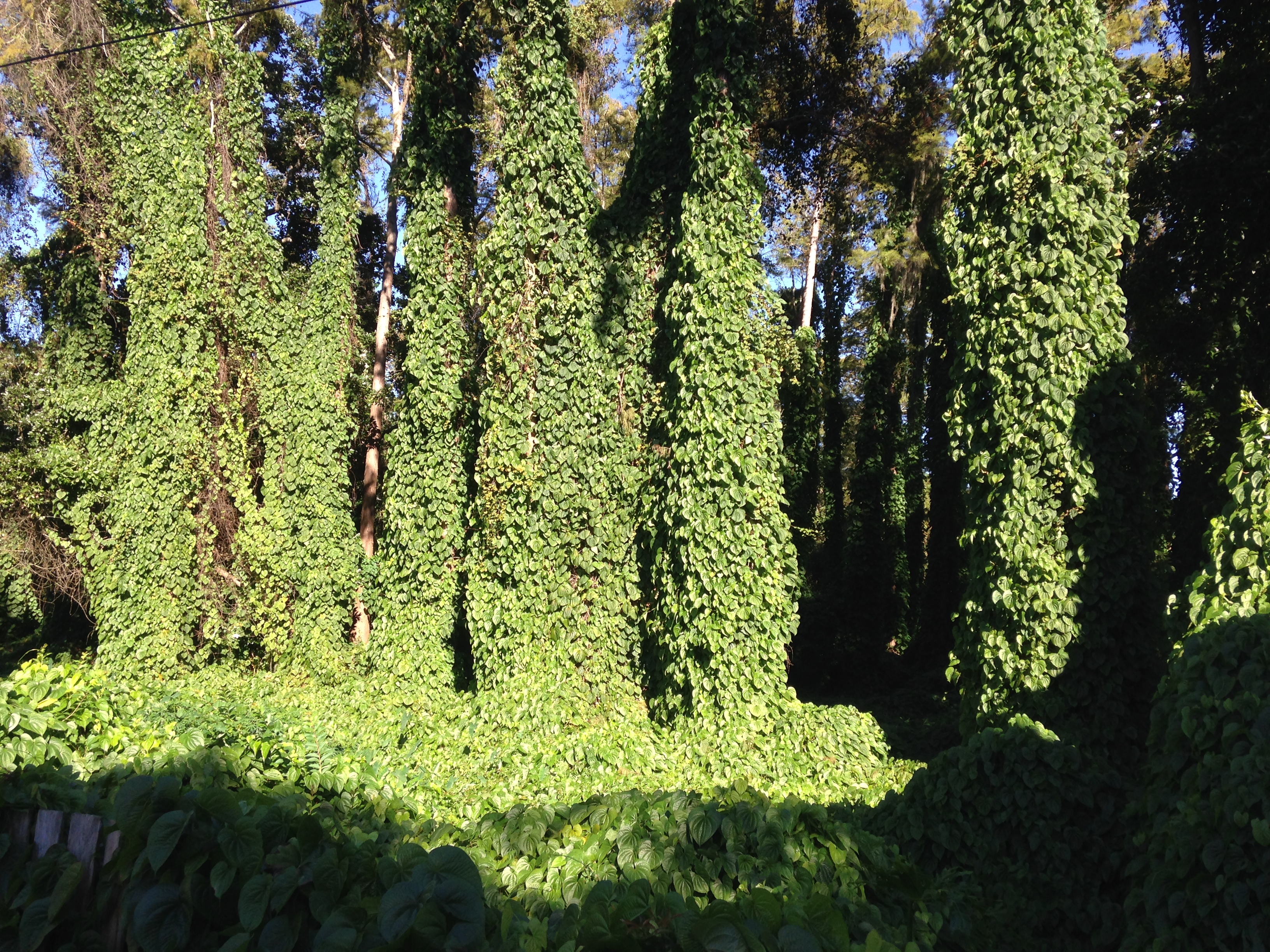
by Julie McConnell | May 23, 2018
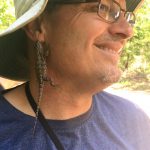
Dr. Steve Johnson, UF/IFAS Associate Professor of Wildlife Ecology will be the featured speaker on June 6th
June 6th is a great day to learn about all types of invasive species that threaten natural areas in Northwest Florida!
The UF/IFAS Extension Bay County office will have multiple educational exhibits with living samples of species of concern from 9 a.m. – 5 p.m. on Wednesday, June 6th. This is a multi-agency effort to inform citizens about the impact of invasive plants and animals and how they can help reduce introduction and spread. For full details see the Bay_Invasive Workshop Flyer
We are pleased to announce our partners Florida Fish and Wildlife Conservation Commission (FWC) and Science and Discovery Center of Northwest Florida will be on hand to share information about caring for exotic pets and current management plans for invasive species such as Lionfish, Aquatic Weeds, and how to surrender an animal on designated Pet Amnesty Days.
At noon there will be a special guest speaker for a bring your own lunch & learn “Exotic Invaders: Reptiles and Amphibians of Concern in NW FL.” Dr. Steven Johnson, UF/IFAS Associate Professor of Wildlife Ecology, will talk about exotic reptiles and amphibians we should be aware of that may occur in our area.
In the morning, we will be focusing on the invasive air potato vine with the distribution of air potato leaf beetles for biological control. Need air potato leaf beetles to manage the air potato vine on your property? Please register here http://bit.ly/bayairpotato to receive beetles – they will be distributed from 9 a.m. – noon on June 6th.
Learn more about the success of the Air Potato Biological Control program at http://bcrcl.ifas.ufl.edu/airpotatobiologicalcontrol.shtml
#invasivespecies
by Ray Bodrey | May 4, 2018
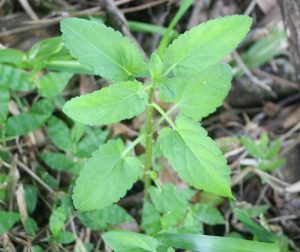
Figure 1: Florida Betony, Stachys floridana. Credit: UF/IFAS Range Cattle Research & Education Center.
If you look closely at your yard, there is a good chance that you will find a plant that, depending on who you ask, is considered either a native wildflower or a weed and there are more than a few species that fit this description. If, upon even closer inspection, you find a plant with root tubers that resemble egg casings or even a rattlesnake’s rattle, you’ve stumbled upon Florida Betony.
Stachys floridana is a perennial broadleaf commonly referred to as rattlesnake weed due to it’s fleshy, white, segmented underground tubers. The plant has an erect stem with leaves that are opposite, shovel-shaped and coarsely serrated. The plant structure is very similar to mint. Flowers, emerging in late spring, are pinkish-purple in color. These inflorescences will also produce fruit, consisting of four nutlets. However, reproduction of the plant and it’s propensity to spread through lawns and gardens primarily occurs through dense root tuber development. Florida Betony’s growing range was originally confined to the state of Florida, but the commercial nursery trade played a major hand in dispersing the plant across the Southeast in the mid-1900’s. It can now be found as far west as Texas and as far north as North Carolina.
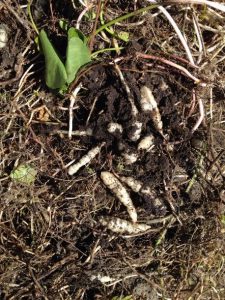
Figure 2: Tubers of the Florida Betony. Credit: Jill Bebee, UF/IFAS Gulf County Master Gardener.It can now be found as far west as Texas and as far north as North Carolina.
This time of year is when Florida Betony thrives. The moderate temperatures of fall and spring are the prime growing periods for Betony. In the heat of the summer, the above-ground structure of the plant will struggle and often disappear completely, only to reemerge in the fall. As a lawn weed, managing tuber development is key to controlling this plant. Applying herbicide to the leaves and stalk may seem at first to have conquered the weed. However, in most cases the tuber will simply regenerate. Glyphosate (Roundup) can be used effectively for control in ornamental plant beds where no turf is present. Be careful when spraying herbicides around trees, shrubs and other desirable plants as any foliar contact will cause phytotoxicity. If you have an infestation of Florida Betony in your turfed areas, there are a few options for control. Regular applications of three way broadleaf herbicides, such as mixtures of 2-4D, Dicamba and Mecoprop, are effective at suppressing this pesky plant. For more information and options, please contact your local county extension office or see the supporting information links below. Always refer to the product label for specific uses, precautions and application rates when using any herbicide.
Supporting information for this article can be found in the following the UF/IFAS EDIS publication, “Florida Betony Biology and Management in Turf” by J. Bryan Unruh, Ramon G. Leon, and Darcy E. P. Telenko: http://edis.ifas.ufl.edu/pdffiles/EP/EP38800.pdf

by Les Harrison | Apr 23, 2018
Spring 2018 is barely out of the starting gate. All kinds of plants are sprouting and producing blooms! This week’s last gasp of winter temperatures slowed the progress, but only slightly.
Much like the Easter egg hunts a few weeks ago, a search of the landscape can bring multiple surprises. Two colorful plants, spiderwort and rustweed, which are growing in the region fit into this category.
Tradescantia ohiensis, the scientific name for spiderwort, is a herbaceous native plant. Its most striking feature which makes it easily identifiable is the cluster of bright purplish-blue blooms which are currently on display.

Spiderwort in full flower. Image Credit Les Harrison
To the casual listener, the name spiderwort implies an arachnid with a complexion issue. Far from it, but the terminology is shrouded in agriculture and horticulture history.
The term wort, in its various forms, can be traced back to northern Europe to well over 1,000 years ago. Its meaning related at first to herbs, and then to plants without bark or hard stems.
It should not be confused with wart, a skin eruption relating to a virus. Contact with any part of the spiderwort does not infect a person with warts.
The spider part of the name relates to the flower peddles. In harsh sunlight of the afternoon, the Spiderwort’s peddles are reduced to fine threads similar to a spider’s web.
Spiderworts are often seen along fencerows, in pastures and untended fields, and it forested areas. They bloom from late spring to early summer and usually grow in clumps or bunches of plants.
The plant clumps are easily separated and transplanted. Spiderwort has been used in ornamental horticulture as a showy, low-cost alternative for many years.
They expand their presence in the wild slowly, but persistently. Since there are no herbicides labeled for their control, they are considered a pest species by some hay producers.
Another plant with a colorful name, and which is considered a pest, is the rustweed (Polypremum procumbens). While it does not literally rust, it gets its name from its rust colored foliage in the autumn.
In spring and summer this low growing perennial is a Kelly green fitting for St. Patrick’s Day, and easily blends with Bermudagrass and other turfs as they make their season emergence. Tiny white blooms soon to come will confirm it presence, but this is often overlooked when in landscapes and lawns.
This plant spreads by seed, which are small and heart-shaped. One means of colonizing new areas is by seed lodging in mowing and other equipment, then depositing in new areas when the equipment is relocated.
As with all grasses in the Florida panhandle, rustweed is found only in sunny areas. This little known plant is an area native, but also occurs as far away as South America.
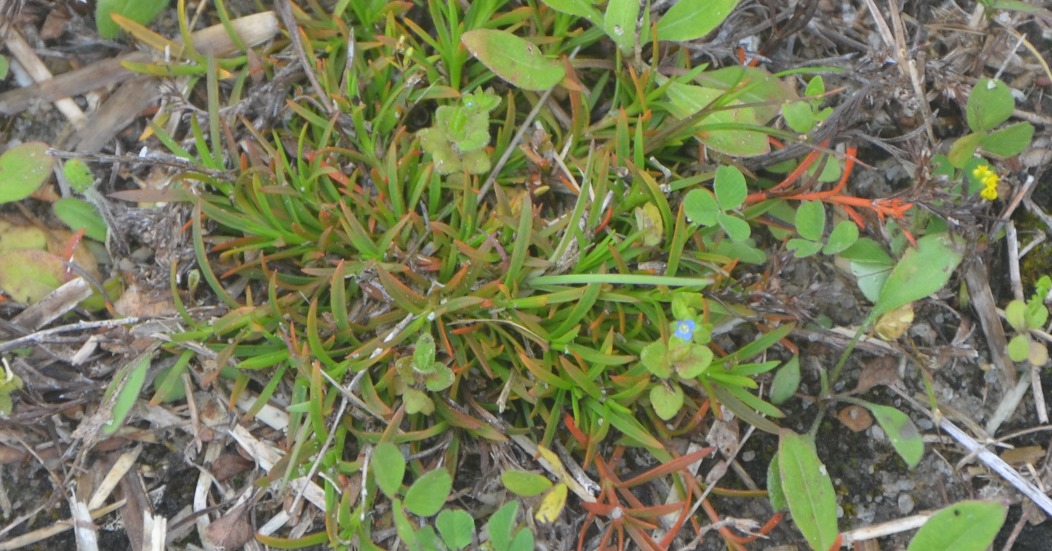
Rustweed, among others, in a Florida lawn. Image Credit Les Harrison
This aggressive native will quickly establish itself and push out other more desirable species. Mowing will not slow its progress.
After the multiple frost and muted earth tones, both spiderwort and rustweed are currently adding variation to the landscape’s hues as the weather warms.
To learn more about weeds in north Florida, contact your local UF/IFAS County Extension Office. Click here for contact information.
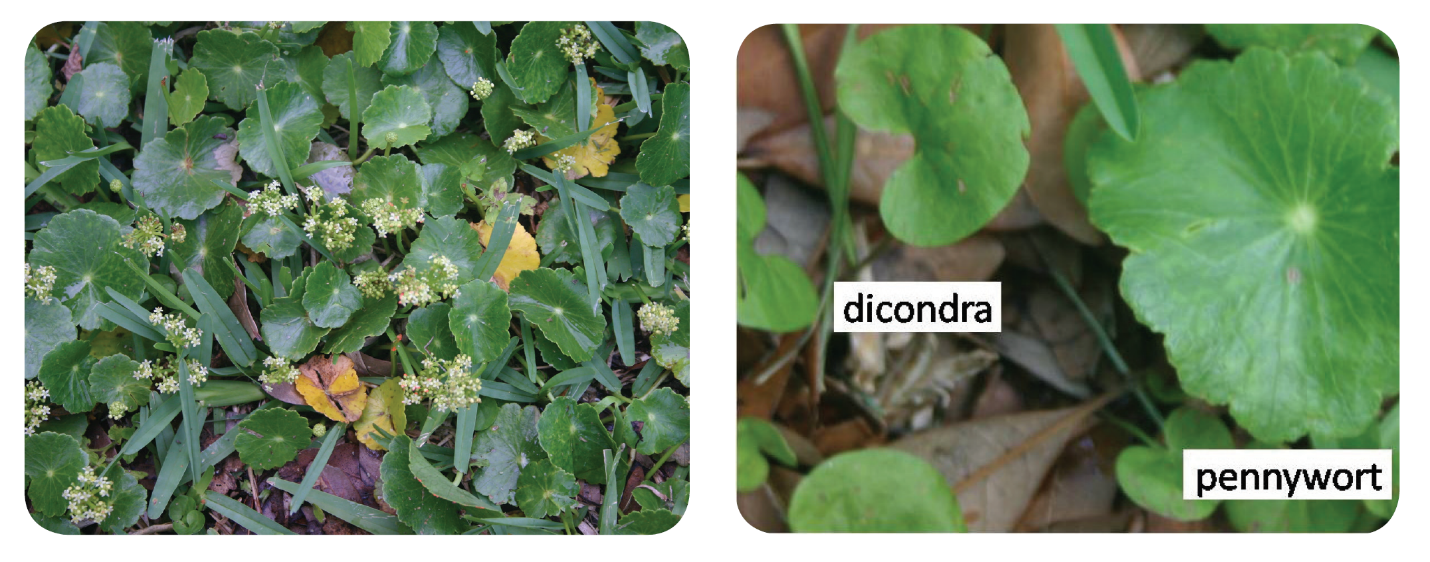
by Ray Bodrey | Feb 5, 2018
We have many weeds in the Panhandle that are a nuisance to our landscape, with some being very difficult to control. Dollarweed certainly falls into this category. But, does dollarweed have an upside?
Dollarweed (Hydrocotyle spp.) is a largeleaf creeping perennial that thrives in central and northern Florida, but is found throughout both Atlantic and Gulf coasts. Dollarweed is resilient, as it can reproduce by seed, rhizomes and tubers. The mature plant produces vertical shoots with shiny green round shaped leaves and scalloped edges. The leaves can grow up to the size of a silver dollar, hence the plant’s name. This plant grows low to the ground and thrives in moist environments.
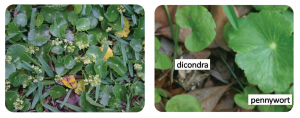
Figure 1: Pennywort (Dollarweed) vs. Dicondra.
Credit: Ramon G. Leon, Darcy E. P. Telenko & J. Bryan Unruh, UF/IFAS
Hydrocotyle umbellate is the species most found in Florida lawns. In city landcsapes, dollarweed can be an indicator of leaking water mains or even septic drainfield problems. It also can be an indicator that you may be over-irrigating your lawn. Hydrocotyle bonarienies or pennywort, on the other hand, is a species that is found on frontal and back dune areas, along with sandy marsh or flatlands. This species is known to help stabilize dunes and assist in combatting dune erosion.
Often, dollarweed is confused with pony’s foot or Dicondra carolinensis. This weed will grow along with dollarweed, as it prefers moist environments as well. Pony’s foot has a distinct difference in leaf structure than dollarweed. Pony’s foot has a kidney-shaped circular leaf, as dollarweed is disc shaped.
How does one control dollarweed in a landscape? Pulling it up by hand can be successful. However, it’s a must to pull all of the white rhizomes from the soil. Otherwise, the plant will rebound quickly. Selective & non-selective herbicides will control dollarweed. However, you must be persistent. Applying a pre-emergent and post emergent herbicide is the best practice when using chemical applications. There are many herbicides on the market that specifically list the control of dollarweed, such as atrazine and 2, 4-D options. Always follow the directions and precautions from the manufacturer when using a herbicide and be sure that the product will not affect your variety of turfgrass. Contact your local county extension office for more information on controlling dollarweed and other pesky weeds.
Supporting information for this article can be found in the following the UF/IFAS publication:
“Pennywort (Dollarweed) Biology and Management in Turf” by Ramon G. Leon, Darcy E. P. Telenko and J. Bryan Unruh: http://edis.ifas.ufl.edu/pdffiles/EP/EP38900.pdf
& “Native Plants for Coastal Dune Restoration- What, When and How for Florida” by M.J. Williams, USDA NRCS: https://www.nrcs.usda.gov/Internet/FSE_PLANTMATERIALS/publications/flpmspu7474.pdf
UF/IFAS Extension is an Equal Opportunity Institution.
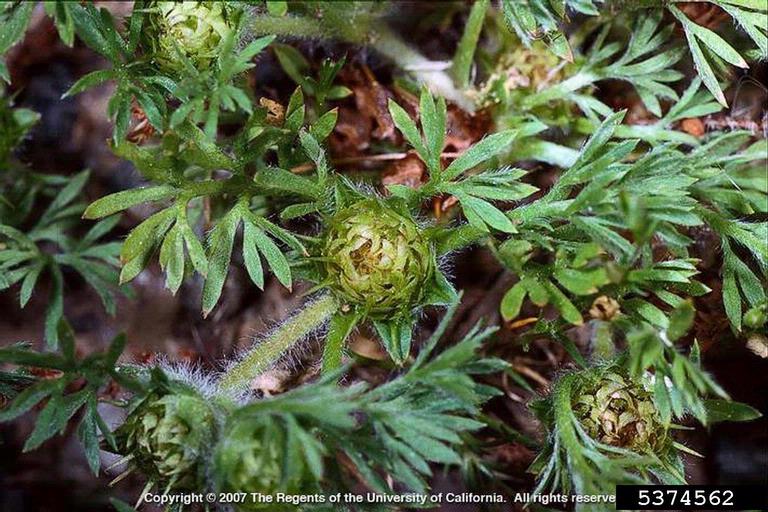
by Matthew Orwat | Oct 10, 2017
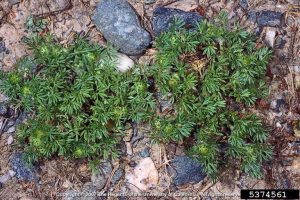
Burweed, Soliva Sessilis. – Image Credit: Joseph M. DiTomaso, University of California – Davis, Bugwood.org. Creative Commons License
On the top of my list of lawn related annoyances is stepping into a patch of burweed, Soliva sessilis, which is in the sunflower family and is also known as spurweed. The leaves are opposite along the stem and sometimes resemble parsley. The main ways in which burweed can irk the casual gardener are sticking to socks, sneaking in with the dog, or littering flower beds with its nuisance. It can also hide in the house and reappear when shoes are removed. This causes pain in both the foot and the ear.
Lawn burweed has been an especially noticeable problem in lawns. Over the years, extension offices throughout Northwest Florida have been fielding many questions and finding solutions to lawn burweed infestations!
Maintaining a healthy vigorous lawn will prevent weeds from taking over. If your lawn is reasonably healthy and only a few instances of this weed exist, try to mechanically remove them and encourage the lawn to outgrow them.
If an infestation of burweed occurred last year on a specific patch of turf, take note. The best time to apply pre-emergent herbicides to control burweed is in October, when nighttime temperatures drop to between 55-60 degrees F for a few consecutive nights. A widely used pre-emergence product for burweed control is isoxaben, which is sold under the brand name of Gallery as well as others. It prevents the weed from emerging from the ground when it germinates and can be used on St. Augustine, centipede, bahia and zoysia lawns, as well as in ornamental shrub beds. In northwest Florida, this herbicide needs to be applied in October for best results. A second application later in the season might be warranted. For more information about control, please consult this excellent article on lawn burweed management.
Now is the time to control burweed before it gets started. As temperatures cool burweed seed will germinate, as it is a winter annual. In cases where it is already coming up, control with post-emergent herbicide may be warranted.
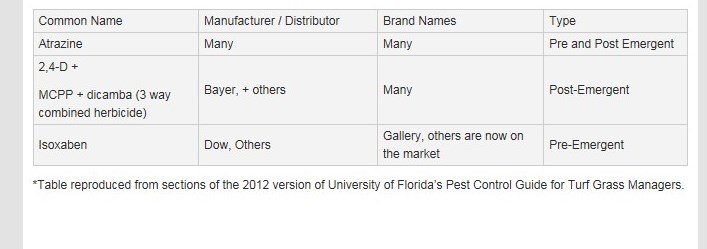
The active ingredients mentioned above are present in a variety of ‘trade name’ products* available from your local garden center, farm supply or co-op. Be sure to read label instructions carefully and contact your local extension office for any assistance. I hope all the northwest Florida lawn managers prevent burweed this fall so that lawns will be burweed free next spring.
Happy Gardening!
by Daniel J. Leonard | May 18, 2017
If you’re like me, growing turfgrass is often more of a hassle than anything else. Regardless of the species you plant, none tolerates shade well and it can seem like there is a never-ending list of chores and expenses that accompany lawn grass: mowing (at least one a week during the summer), fertilizing, and constantly battling weeds, disease and bugs. Wouldn’t it be nice if there were an acceptable alternative, at least for the parts of the lawn that get a little less foot traffic or are shady? Turns out there is! Enter the wonderful world of perennial groundcovers!
Perennial groundcovers are just that, plants that are either evergreen or herbaceous (killed to the ground by frost, similar to turfgrass) and are aggressive enough to cover the ground quickly. Once established, these solid masses of stylish, easy to grow plants serve many of the same functions traditional turf lawns do without all the hassle: choke out weeds, provide pleasing aesthetics, reduce erosion and runoff, and provide a habitat for beneficial insects and wildlife.
The two most common turfgrass replacements found in Northwest Florida are Ornamental Perennial Peanut (Arachis glabra) and Asiatic Jasmine (Trachelospermum asiaticum); though a native species of Mimosa (Mimosa strigillosa) is gaining popularity also. All of these plants are outstanding groundcovers but each fills a specific niche in the landscape.

Perennial Peanut Lawn
Perennial Peanut is a beautiful, aggressive groundcover that spreads through underground rhizomes and possesses showy yellow flowers throughout the year; the show stops only in the coldest winters when the plant is burned back to the ground by frost. It thrives in sunny, well-drained soils, needs no supplemental irrigation once established and because it is a legume, requires little to no supplemental fertilizer. It even thrives in coastal areas that are subject to periodic salt spray! If Perennial Peanut ever begins to look a little unkempt, a quick mowing at 3-4” will enhance its appearance.

Asiatic Jasmine
Asiatic Jasmine is a superb, vining groundcover option for areas that receive partial to full shade, though it will tolerate full sun. This evergreen plant sports glossy dark green foliage and is extremely aggressive (lending itself to very rapid establishment). Though not as vigorous a climber as its more well-known cousin Confederate Jasmine (Trachelospermum jasminoides), Asiatic Jasmine will eventually begin to slowly climb trees and other structures once it is fully established; this habit is easily controlled with infrequent pruning. Do not look for flowers on this vining groundcover however, as it does not initiate the bloom cycle unless allowed to climb.

Sunshine Mimosa
For those that prefer an all-native landscape, Sunshine Mimosa (Mimosa strigillosa), also known as Sensitive Plant, is a fantastic groundcover option for full-sun situations. This herbaceous perennial is very striking in flower, sending up bright pink, fiber-optic like blooms about 6” above the foliage all summer long! Sunshine Mimosa, like Perennial Peanut, is a legume so fertility needs are very low. It is also exceptionally drought tolerant and thrives in the deepest sands. If there is a dry problem spot in your lawn that receives full sun, you can’t go wrong with this one!
As a rule, the method of establishing groundcovers as turfgrass replacements takes a bit longer than with laying sod, which allows for an “instant” lawn. With groundcovers, sprigging containerized plants is most common as this is how the majority of these species are grown in production nurseries. This process involves planting the containerized sprigs on a grid in the planting area no more than 12” apart. The sprigs may be planted closer together (8”-10”) if more rapid establishment is desired.
During the establishment phase, weed control is critical to ensure proper development of the groundcover. The first step to reduce competitive weeds is to clean the site thoroughly before planting with a non-selective herbicide such as Glyphosate. After planting, grassy weeds may be treated with one of the selective herbicides Fusilade, Poast, Select, or Prism. Unfortunately, there are not any chemical treatments for broadleaf weed control in ornamental groundcovers but these can be managed by mowing or hand pulling and will eventually be choked out by the groundcover.
If you are tired of the turfgrass life and want some relief, try an ornamental groundcover instead! They are low-maintenance, cost effective, and very attractive! Happy gardening and as always, contact your local UF/IFAS County Extension Office for more information about this topic!














